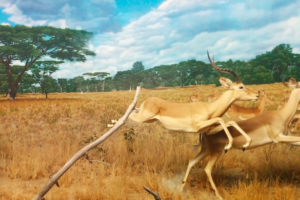Last time we looked at the foot and ankle, we discussed an essential function as an antenna – sensing and signaling for muscle activity based on stretch receptors housed in muscle, tendon, ligament, fascia, and skin.
Stretch receptors sense the joint movement and tissue tension when the foot/ankle interacts with the ground and signals the various muscle chains throughout the whole body that create and control the whole body each step. Think of the board game Mouse Trap – a cascade of events and activity to catch a mouse likens to a cascade of signals and muscle activity to take a step – again and again.
(The proprioception/stretch reflex activity for creating and controlling movement and stability occurs throughout the entirety of our body, not just foot/ankle.)
Mechanically, every muscle below the knee has responsibility in controlling the internal rotation and adduction of the distal leg, foot, and ankle.
Let’s say we turn off our muscle activity as we are taking a step. What happens?
Gravity takes over as the force acting on our body (joints). Gravity and our joint alignment will cause our ankle, knee, and hip to
Flex (bend forward)
Adduct (bend inward) and
Internally Rotate (rotate inward).
That concert of motion at the three major regions of our leg will cause us to collapse.
That inward motion at the knee, if unchecked, is how we tear an ACL (and often an MCL and medial meniscus) in a non-collision injury.
Muscle at the foot and ankle complex are attached and aligned around the various joints therein to control this ‘descent’ of the arch and inward/forward motion of the distal leg created by gravity. All of the muscles.
Twisting and shifting of the tibia inward.
Pronation of the arch.
All of the muscles down there.
They have influence on knee position and a fair amount of responsibility for knee health and protection.
They have control of foot/ankle stability and activity.
Think of your leg as a team of three teammates.
The main power for running comes from the hip (and torso).
Some power comes from the muscle at the knee,
And some from the foot and ankle complex.
If the hip (and torso) are less efficient at producing/controlling power and motion,
You have good teammates to help make up the difference.
Muscle at the knee will try harder
As will muscle at the foot/ankle.
They are handling their own workload
And now some additional workload that the hip couldn’t cover.
That is essentially how it goes.
And most of the time, it works.
These compensatory patterns
Are how we move,
How we run.
We operate at varying levels of inefficiencies.
The system (to an extent) is set up to handle it.
Until it can’t.
That’s when we start to get aches, pains, cramps, tightness, altered mechanics, injury…
Let’s take the calf muscle. It helps produce/control/refine movement in all three planes.
Let us say that a muscle group of the hip is less efficient at producing power.
The calf complex is a good friend and takes up the slack;
Now doing its own job and some of the job of the hip.
The overwork will cause the calf muscle to fatigue sooner.
When I get tired, I can sit and take a break.
Muscle tissue does not operate that way exactly.
Going through repetitive contract-relax cycles during movement,
As muscle tissue fatigues,
It doesn’t simply decrease tone or take a break.
It does a bit of the opposite –
It actually tightens up.
Increases stiffness.
It appears as though it is easier for the muscle to increase its stiffness and tension as a whole
Than to continue finessing its contract-relax cycles.
Increased intrinsic tension.
Decreased joint movement.
Both of which can alter muscle and joint activity in its region as well as other regions.
Decreased efficiency.
Decreased quality motion.
Increasing fatigue.
Increased energy/fuel to continue at this decreased efficiency.
Breakdown, aches, pains, injury…
There is a brief overview of how mechanical breakdown can occur
Via the teammate example.
Now let’s look at what happens with that same muscle fatigue and stiffness of the calf in the neuro-muscular reflexive system.
That increased muscle stiffness alters the stretch of itself (muscle) and the stretch and motion of the joints it is associated with.
That alters the signaling of our stretch receptors and reflexive nature of our gait.
It can alter the timing and overall output of the (power) muscle groups that are signaled,
Further decreasing efficiency and output of hip muscle
That can further ask the calf muscle to try even harder to make up for the lost workload.
And the snowball continues…
Think of the time spent running on pavement. Our bodies and joint/muscle regions get accustomed to a certain workload and muscle timing.
And then we hit the trails. The distal muscle has to work harder to do their own job. As do the proximal hip muscle groups. If the power and stability of our trunk and hips can’t handle the increased strength demand and mobility demand, they will do two things:
Stiffen up to allow for less motion, or
Ask for help.
And it becomes significantly harder,
More clunky,
And even higher stress on our distal muscle groups.
Decreasing their stretch receptor activity.
And there goes another snowball.
Increased motion in some areas,
Decreased motion in others.
Increased joint compression.
Awkward muscle tension.
For a number of reasons, we are starting to see the importance of tissue flexibility.
Not necessarily stretching for length,
But the supple nature of healthy muscle tension and motion experienced to allow
for the timing and sequencing and power, and range of motion.
That our intentions on influencing our muscle suppleness needs to understand these types of activities and patterns
So a prolonged, static stretch or significant pressure during a muscle release or rolling could actually exacerbate, not help the situation.
It shows us the we need to know how to read the room.
Understand what we need for our muscle to do in the situation and pick
the intervention accordingly.
Now we are starting to touch on the art of discernment in navigating running, health, and such.
Not just picking slot A for hole B
When equating tightness to needing length.
That is why research shows no significant difference in how stretching before/after an activity affects the occurrence of injuries – they only look at the presence or absence of a ‘stretch’ (static, dynamic, rolling, releasing). They don’t look at what a muscle actually needs in order to work better (is it overworking and needs down-regulation, underworking and needs up-regulation, is it actually short…?).
That is why many of us don’t bother much with pre- or post-run muscle ‘treatment.’ We haven’t paired our muscle needs with the appropriate muscle activity.
So, if that was a little bit about muscle balance, timing, muscle health, muscle length, tension, and that selecting a stretch, roll, release, etc depends on if the muscle needs length, is overactive and needs down-regulation, under-active and needs up-regulation,
And, if that is (some) of the deal with our foot/ankle,
Wouldn’t shoes and inserts mess all of that motion, sensing, and timing up?
Great question
And for that,
We turn to the Copper Canyons.
© Dr Adam Fujita




